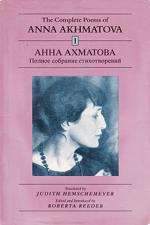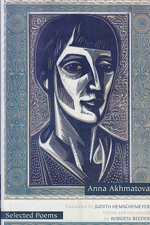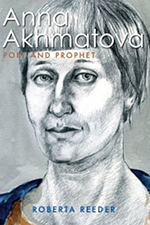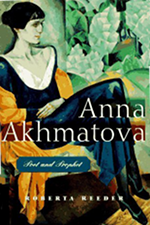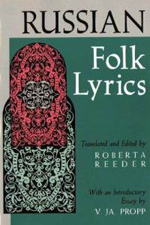BOOKS, ARTICLES, CONFERENCES, LECTURES
LITERATURE
BOOKS
- ANNA AKHMATOVA: POET AND PROPHET. NY: St. Martin’s Press, 1994. Paperback 1995. Revised and expanded edition. Los Angeles, CA: Figueroa Press (U. of Southern California), 2007. Biography of Akhmatova: her life and works. Chosen as one of the best books of the year by the New York Times, 1994. Read more…
- COMPLETE POETIC WORKS OF ANNA AKHMATOVA. Edited and Introduction by Roberta Reeder. Trans. Judith Hemschemeyer with Roberta Reeder. Boston, MA: Zephyr Press. 1st ed. 1990, 2nd ed. 1993, 3rd ed. 1997. First edition: Russian and English. Later editions only English. Chosen as one of the best books of the year by the New York Times, 1992. Read more…
- THE SUPERNATURAL IN EASTERN EUROPEAN LITERATURE, ed. Roberta Reeder and Amy Mandelker. Columbus, Ohio: Slavica, 1988. Festschrift for Victor Terras.
- PUSHKIN’S PROSE by A. Lezhnev, trans. and ed. Roberta Reeder. Ann Arbor, Michigan: Ardis Press, 1985.
ARTICLES
- “Russian Folklore and the Bible,” THE BIBLE IN FOLLORE WORLDWIDE, ed. Eric Ziolkowski, 2 vols. (Berlin: De Gruyter, forthcoming)
- “Russian Folklore and the Bible,” ENCYCLOPEDIA OF THE BIBLE AND ITS RECEPTION, vol. 9, Berlin: Walter de Bruyter 2014
- “Anna Akhmatova and the Bible,” ENCYCLOPEDIA OF THE BIBLE AND ITS RECEPTION, vol. 1, Berlin: Walter de Gruyter, 2009
- “Akhmatova’s Poems: The Stalin Period,” NEW ENGLAND REVIEW, 1996
Analysis of poems against Stalin unpublished during Akhmatova’s lifetime. - “From Another World: Four Translations of Akhmatova’s Requiem,” O RUS! Studia Literaria Slavica. In Honorem Hugh McLean, ed. S. Karlinsky, et al. Oakland, CA, 1995.
- “Tsarskoe Selo in the Poetry of Anna Akhmatova. The Eternal Return,” THE SPEECH OF UNKNOWN EYES, ed. Wendy Rosslyn. Nottingham: Astra Press, 1990.
Tsarskoe Selo as a symbol of the impact of history on Akhmatova’s life - “The World of Art,” HANDBOOK OF RUSSIAN LITERATURE, ed. Victor Terras. New Haven, CN: Yale University Press, 1985.
Analysis of the often neglected literary aspect of the famous World of Art journal edited by Serge Diaghilev. - “Literature as Epistemology,” SEMIOTICA, 1983.
Historical analysis of Yuri Lotman’s theories as the culmination of Russian literary critical strategies from Russian Symbolism, Formalism, and Structuralism to Semiotics. - “Queen of Spades: A Morphological Analysis” in NEW PERSPECTIVES ON NINETEENTH-CENTURY RUSSIAN PROSE, Columbus, Ohio: Slavica, 1982.
Employing V. Propp’s morphological analysis of the folk tale, this interpretation also uses Jungian theory for analysis of Pushkin’s Queen of Spades as a parody of the E.T.A. Hoffmann Kunstmärchen (art fairy tale). - “Tin Ujević: Odakle ide veče,” SOUTHERN EUROPEAN JOURNAL, 1982.
Analysis of existentialist themes in poems by the Croatian Surrealist poet Tin Ujević. - “The Greek Anthology and its Influence on Pushkin’s Poetic Style,” CANADIAN/AMERICAN SLAVIC STUDIES, 1979.
Influence of the Greek Anthology poems on the dramatic change in Pushkin’s poetic style. - “The Black Cat–A Reinterpretation,” POE NEWSLETTER, 1973.
Jungian psychological analysis of Edgar Allan Poe’s story “The Black Cat”.
PAPERS
- “Akhmatova: Poet and Prophet,” BISTROT ART AND POETRY SERIES. Venice, Italy, 2004.
- “Three Russians on the Isle of the Dead: Stravinsky, Diaghilev, Brodsky,” ASSOCIAZIONE ITALO-RUSSIA, Venice, Italy, 2004.
- “Metonymic Images in Akhmatova’s Lyrics,” AKHMATOVA CONFERENCE, Macerata University. Macerata, Italy. May, 2000.
- “Church Bells: Symbol and Metaphor in Akhmatova’s Poetry,” AMERICAN ASSOCIATION FOR ADVANCEMENT OF SLAVIC STUDIES, Seattle, 1997.
- “Akhmatova and the Stalinist Terror,” POLITICS AND POETRY CONFERENCE, Women’s Studies Program: Brandeis University, Waltham, MA 1997
- “Creating the Visual Myth of Soviet Women,” Chairman of Panel AMERICAN ASSOCIATION FOR ADVANCEMENT OF SLAVIC STUDIES, BOSTON, 1996.
- “Akhmatova’s Poem without a Hero: A Semiotic Study of Literary and Theater Codes” AMERICAN ASSOCIATION FOR ADVANCEMENT OF SLAVIC STUDIES, Boston, 1996.
- “The Missing Hero: Mikhail Bulgakov’s Last Days and Jaroslaw Iwaskiewicz’s Summer in Nohant” GERMAN-PUSHKIN SOCIETY CONFERENCE. Hamburg, Germany, 1995
- “Pushkin Reflected in the Mirrors of Akhmatova and Tsvetaeva,” GERMAN-PUSHKIN SOCIETY CONFERENCE, Gõttingen, Germany, 1993.
THEATER
ARTICLES
- “Alexander Ostrovsky’s Diary of a Scoundrel, trans. Roberta Reeder, 1987.
Performed at the Huntington Theater, Boston, 1987. - “Petrushka: A Russian Rogue,” THE PUPPETRY JOURNAL, 1981
History of the Petrushka puppet shows in Russia and in the early period of the Soviet Union - “Red Riding Hood and The Topeng Tradition,” THE DRAMA REVIEW, 1980.
Semiotic analysis of an adaptation by John Emigh of performance codes from the Indonesian Topeng performance tradition. Satire on the Three Mile Island nuclear plant disaster in the United States. - Vladimir Frolov, “Tragicomedy” and Anna Tamarchenko, “Overcoming the Canons,” trans. Roberta Reeder.
Soviet criticism of contemporary Russian theater for “NEH Seminar: Eastern European Contemporary Theater,” City University of New York, 1980. - “Semiotics of Art,” SEMIOTIC SCENE, 1979
Analysis of articles by Czech Structuralists on theater performance, art and film. - “Satirical Devices in Marin Držić’s The Miser,” SLAVIC EAST EUROPEAN JOURNAL, 1977
Satirical devices in a Croatian Renaissance interpretation of Plautus’ Pot of Gold. - Ranko Marinković, Gloria, in FIVE MODERN YUGOSLAV PLAYS, trans. Roberta Reeder and David Mladinov. New York: Ungar, 1976.
Satire against corruption in the clergy. - GORKY ISSUE of YALE THEATER, 1976
Translation of articles and memoirs for a special issue of the journal YALE THEATER devoted to Maxim Gorky.
FILM
BOOK
- NON-INDIFFERENT NATURE by Sergei Eisenstein, trans. by Roberta Reeder, ed. Herbert Marshall. Cambridge: Cambridge University Press, 1988.
ARTICLES
- “Shadows of Forgotten Ancestors: a Study in the Supernatural,” THE SUPERNATURAL IN EASTERN EUROPEAN LITERATURE. Columbus, Ohio: Slavica, 1988.
Analysis of film devices used by Sergey Paradzhanov to convey the supernatural in this story by Mykhailo Kotsiubynsky about peasants in the Carpathian mountains. - “Eisenstein’s Strike: Puppets, Propaganda, and Posters,” RUSSIAN LITERATURE TRIQUARTERLY, 1988.
Influence of agit-prop posters and propaganda puppet shows on Eisenstein’s film Strike. - V.V. Ivanov, “Functions and Categories of Film Languages,” trans. Roberta Reeder. FILM CRITICISM, 1984
- “Archetypal Criticism and Red River,” CINETRACT, 1980.
Application of Northrop Frye and Carl Jung’s archetype theories to the American Western. - Sergei Eisenstein, “On a Materialist Approach to Form,” trans. Roberta Reeder, THE AVANT-GARDE FILM, ed. P. Adams Sitney. NY: New York University Press, 1978.
- Sergei Eisenstein, “Piranesi and the Fluidity of Form” trans. Roberta Reeder, OPPOSITIONS. Cambridge, MA: MIT Press, 1978.
PAPERS
- “Eisenstein’s Battleship Potemkin and Gorky’s Mother. Revolution and Art” YALE CENTENNIAL CELEBRATION IN HONOR OF MAXIM GORKY. Yale University, 1986.
Analysis of the similarity and contrast of film and literary techniques employed in the presentation of the 1905 Russian Revolution. - “Eisenstein’s Strike and Agit-Prop Art,” AMERICAN ASSOCIATION FOR ADVANCEMENT OF SLAVIC STUDIES, 1980.
Visual vocabulary of characters, costumes, and gestures derived by Eisenstein from Mayakovsky ROSTA posters. - “The Aesthetics of Socialist Realism and Russian Film,” HARVARD UNIVERSITY FILM AND VISUAL STUDIES DEPARTMENT, 1980.
The development of the theory of the didactic function of art from Plato and Horace to Socialist Realism. - “The Role of Painting in Eisenstein’s Theory and Cinema,” NEW ENGLAND SLAVIC ASSOCIATION, 1979.
Influence of Russian icons, Da Vince, El Greco, and Piranesi on Eisenstein’s film theory. - ”Aesthetics of Dziga Vertov’s Films,” RHODE ISLAND SCHOOL OF DESIGN, 1978.
Techniques specific to film media employed by Vertov in Man with a Movie Camera.
ART
ARTICLES
- “Those Who Live in Glass Houses: Socialist Realist Painting,” BOSTON REVIEW, 1998.
The philosophy of Socialist Realist painting and its relation to aesthetics from Plato, Horace and Christian aesthetics to Socialist Realism: art as didactic tool. - “Gesamtkunst and Technology in the USSR” in GESAMTKUNSTWERK ZWISCHEN SYNAESTHESE UND MYTHOS. Bielefeld, Germany: Aisthesia Verlag, 1994.
Analysis of theories of synesthesia in Russia and the Soviet Union from Kandinsky and Scriabin to Thermin and Bulat Galeev. - “Music of Light in the Soviet Union,” EIGENWELT DER APPARATEWELT (Pioneers of Electronic Art). Linz, Austria: Arts Electronica, 1992. Written with Claas Cordes.
The role of sequences of projected colored designs based on the parameters of color, saturation, and length of duration similar to parameters of tone, volume, and tempo in music. - “Moving Sculpture: the Art of the Russian Puppet,” JOURNAL OF DECORATIVE ARTS AND PROPAGANDA, 1989.
History of the Russian puppet as an art form. - “The Relationship of Codes in Mayakovsky’s ROSTA Posters,” SOVIET/SOVIETIQUE, 1979.
Semiotic analysis of visual and verbal propaganda in Mayakvosky’s ROSTA posters. - “Mikhail Vrubel: A Russian Interpretation of Fin-de-Siècle Art,” SLAVONIC & EAST EUROPEAN REVIEW, 1976.
First article in English on Mikhail Vrubel, Symbolist artist responsible for the transition from Russian Realism to the Russian avant-garde. - “Semiotics of Art,” SEMIOTIC SCENE, 1979.
Analysis of Czech Structuralist theory of art, film and theater in L. Matejka and R. Tutinik’s SEMIOTICS OF ART.
PAPERS
- “Modigliani: Sculptures and Drawings of Anna Akhmatova,” MODIGLIANI: SCULPTOR. MART, Rovereto, Italy.
Akhmatova as model for Modigliani’s busts and drawings in the period of the creation of Modigliani’s personal style. - “Music of Light in Russia and the USSR,” THEATER AND THE VISUAL ARTS FESTIVAL,, JUSTIS LIEBIG UNIVERSITY, Giessen, Germany, 1991.
- “Gesamtkunst and the Music of Light in the USSR,” CONFERENCE ON GESAMTKUNST. BIELEFELD UNIVERSITY, Bielefeld, Germany, 1991.
- “Russian Architecture: Tradition and Change,” Department of Architecture, COLUMBIA UNIVERSITY, 1988.
- “Igor Grabar and Museum Policy in the New Soviet State,” NEW ENGLAND SLAVIC ASSOCIATION, 1986.
- “The Applied Arts in the Russian Avant-Garde,” RHODE ISLAND SCHOOL OF DESIGN, 1980.
- “Russian Architecture and the Revolution,” Department of Architecture, MIT, 1979.
- “Rodchenko’s Photomontage Illustrations to Mayakovsky’s narrative poem About This, SEMIOTICS SOCIETY OF AMERICA CONFERENCE, 1978.
FOLKLORE
BOOK
- RUSSIAN FOLK LYRICS, trans. and edited by Roberta Reeder. Bloomington Indiana: Indiana University Press, 1993 (revised and expanded edition of DOWN ALONG THE MOTHER VOLGA, Philadelphia, PA: University of Pennsylvania Press, 1975) Read more…
Translation and annotated edition of Russian folk lyrics and monograph by Vladimir Propp.
ARTICLES
- “The Russian Folk Lyric,” “Wedding Ritual Songs,” “Proletarian Songs” in HANDBOOK OF RUSSIAN LITERATURE, ed. Victor Terras. New Haven: Yale University Press, 1985.
- “The Russian Folk Riddle,” SEMIOTICA, 1982.
Structural analysis of the Russian folk riddle applying Chomsky’s generative grammar theory. - ”Petrouchka: A Russian Rogue,” PUPPETRY JOURNAL, January, 1981.
History and analysis of techniques of the Petrouchka puppet shows in Russia and the Soviet Union. - V.V. Ivanov,”The Semiotic Theory of Carnival,” trans. Roberta Reeder. SEMIOTICA, 1980.
The role of cultural codes in Carnival rituals.
PAPERS
- “Yugoslav Women’s Folk Lyrics,” AATSEEL CONFERENCE, 1985.
- “Russian Folklore: Tradition and Change,” CONNECTICUT COLLEGE, 1984.
- “The Russian Folk Fair,” AATSEEL CONFERENCE, 1983.
- “Satire and the Russian Puppet Tradition,” INTERNATIONAL PUPPET CONFERENCE, SMITHSONIAN INSTITUTE, Washington, D.C., 1980.
- “Women in the Russian Folk Lyric,” CONFERENCE ON WOMEN AND FOLKLORE, U. OF PENNSYLVANIA, 1978.
MUSIC
ARTICLES
- “Luigi Nono and the Porous Iron Curtain,” Luigi Nono und der Osten, ed. Birgit Johanna Wertenson and Christian Storch. Mainz, Germany, 2016, pp. 97-115.
Luigi Nono’s first trip to Russia in 1963; discussion of the importance of his direct contact with major Soviet composers like Alfred Schnittke, Edison Denisov and Sofia Gubaidulina. - “Stravinsky’s Les Noces” (with Arthur Comegno), DANCE RESEARCH JOURNAL, vol. 18, no 2 (Winter 1986-1987), pp. 30-61.
Includes an article on traditional Russian peasant wedding rituals, an annotated translation of the libretto of Les Noces, a translation of the poems from Pyotr Kireevsky’s 19th-century collection of Russian peasant wedding rituals (published 1911) used by Stravinsky for his libretto.



